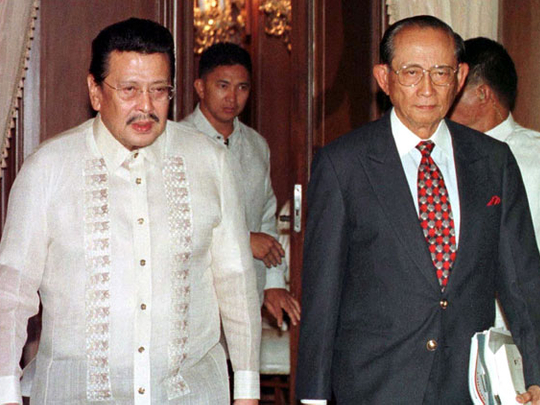
Dubai: Fidel Ramos may not have the charisma as that of actor-turned-politician Joseph Estrada, but he certainly is a master charmer of the media.
During his stint as Philippine president in 1992 to 1998, Ramos valued media coverage, putting premium on every media interview he got. For him, impression management was key.
“He was very close to the media. All his trips, both local and International, had a media component or activities,” Jenny Gonzales, a Dubai-based former senior media relations officer in the Presidential Palace during Ramos’ term, told Gulf News.
Ramos was a “workaholic president” who would start his day reading newspapers, listening to radio, and watching early news from 4am to 6am. He kept abreast with the latest news, and monitored what was being said about his policies through his staff’s tri-media news summary.
Looking at the kind of media coverage his predecessor Cory Aquino received, Ramos knew he had to fraternise with the media — biggest critics of the state — in order to get his agenda across. He was confident that getting positive media coverage locally and abroad would help boost the country’s chances to getting investments from abroad.
And so he leveraged on the attention the media gave him, often bringing them along during his trips abroad.
“He was always prepared to answer questions from the media, and we all know that that’s important in making the media happy. He would candidly initiate conversations with them during the trip,” Gonzales said.
Despite his strict military training, Ramos knew how to take things easy. He would always poke clean fun on media people during the flight.
“Sometimes he would take pictures of the reporters while we’re airborne. He’d go around taking pictures of reporters at their most unflattering moment — when they’re asleep. Then he would show the pictures to them later on and laugh.”
Gonzales said Ramos has a very sharp memory. He knew how to value the people around him, addressing each of them by their name. He would always take them along for a golf or jogging session as he was very health conscious.
While they were in Bangkok in 1997 for the fifth Association of Southeast Asian Nations Summit (Asean), Ramos disappeared while all the other Asean leaders were ready for a photo opportunity.
“We were looking for him. When we turned our heads, we saw him swimming in the pool. All the media ran towards him and, with his goggles on, he waved and dove into the water. The next day, he was on the front page of Bangkok Times.”
Gonzales said that while Ramos sought positive approval, he was not one to compromise when it’s an issue of public concern.
When visiting government projects in the province, Ramos’ background as a military officer and a civil engineer came handy. He berated erring government officials when they delay government-funded construction projects.
“He would always warn them and say, ‘I will be back in a month. I’m familiar with construction because I’m an engineer myself. And I was stationed here when I was a young lieutenant, you can’t fool me.”











